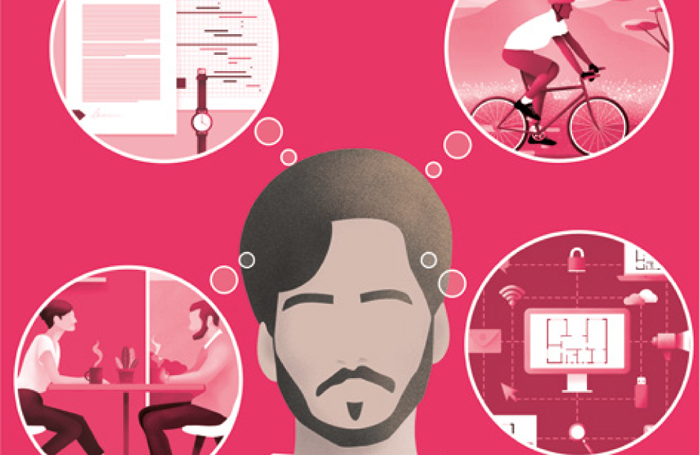It is important to recognise that, all too often, the architectural profession imposes unreasonable stress levels on its practitioners. Gratifyingly, some practices are acknowledging the importance of mental wellbeing within their workplaces and taking steps to ameliorate them.
Twelve practices that share a strong commitment to staff wellbeing came together earlier this year to form the Architects’ Mental Wellbeing Forum, which has now produced the Architects’ Mental Wellbeing Toolkit with the support of the RIBA and the Architects Benevolent Society (ABS). It brings together the lessons they have learnt so far for the benefit of other practices, and any individual in need of support.
One in three architecture students admit to suffering mental health issues of some degree according to a recent study. While there is as yet no comparable research on professional architects, it would seem that wellbeing issues extend into practice.
Priya Aiyer, an architect at MACE who has been a wellbeing ambassador for the ABS for three years, says the profession has well-known problems with long hours and unreasonably tight deadlines.
"I have witnessed time and time again with friends in other practices that they are forced to work long into the night," she states. "What’s worse is that they are not appreciated for it; they don’t even receive a simple 'thank you'. Yet work-life balance is so important in encouraging productivity."
MACE is addressing this problem by defining working days in terms of tasks, rather than number of hours worked. The Mental Wellbeing Toolkit identifies several other measures that practices can implement:
- monitoring staff hours
- carrying out a Stress Risk Assessment
- offering flexible working, paid overtime, and time in lieu
- ensuring staff are supported by time-management and work priority training
Individuals are advised to:
- keep a ‘daily habits’ diary to honestly review the way they work (and their hours)
- to work ‘smart and hard’
- to set daily goals
- avoid multi-tasking where possible (contrary to received wisdom, it is counter-productive)

Senior staff should take the lead in leaving at a sensible hour, providing a ‘trickle-down’ example for everyone else. The Toolkit recommends that practices should have at least one senior staff champion of mental health within the office, who can develop a formal Mental Health Strategy for the practice.
A good first step here is training staff to recognise early signs of a mental health condition via a Mental Health First Aid course. Furthermore, an anonymous staff wellbeing survey can assess the workplace situation and help to identify common sources of stress.
Staff can be directed towards resources such as the Wellbeing Toolkit or the Five Ways to Wellbeing, developed by the New Economics Foundation. The latter is a set of evidence-based actions to improve personal wellness that you can apply to your daily lifestyle (much like eating your ‘five a day’ fruits and vegetables).
Aiyer reports that MACE, which has renamed its former Health and Safety team the ‘Health, Safety and Wellbeing’ team, now has dedicated managers to promote wellbeing and operates a confidential helpline for staff members.

So what is the best course of action for an architect with a pressing mental health issue in a practice yet to establish a support system?
Aiyer says the first step should be a talk with their line manager, who should be open to listening, and prepared to look for options that might help to manage the issue. Managers have a duty of care to employees: if the manager is not able to take any practical steps, then HR would be the next port of call.
"If work proves to be an uncomfortable setting to share mental health issues, I would direct any architect to the ABS," urges Aiyer. "I myself have used their counselling services, which were provided in partnership with the charity Anxiety UK. I was able to access support within a matter of days and I highly recommend them as the first point of call outside of practice."
A variety of other organisations who can listen or offer support are also cited in the AMWF Toolkit. Talking about the matter is always the first step to addressing any mental health issue.
There has, historically, been a stigma attached to admitting that there are mental health issues within a workplace. Aiyer says that she is hearing of more practices appointing wellbeing ambassadors, and enrolling people on Mental Health First Aid courses. She can see the momentum growing.
"Times are certainly changing. I feel that we as an industry need to persevere and drive this forward."
Thanks to Priya Aiyer, Architect, MACE.
Text by Neal Morris. This is a Professional Feature edited by the RIBA Practice team. Send us your feedback and ideas
RIBA Core Curriculum Topic: Health, safety and wellbeing.
As part of the flexible RIBA CPD programme, Professional Features count as microlearning. See further information on the updated RIBA CPD Core Curriculum and on fulfilling your CPD requirements as an RIBA Chartered Member.
There will be a Mental Wellbeing presentation as part of the CPD day at this year's Guerrilla Tactics conference on 6 November 2019. Tickets will be on sale, via the RIBA website, from Thursday 11 July 2019.
Posted on 27 June 2019.









